AMD’s GTX 560 Ti Counter-Offensive: Radeon HD 6950 1GB & XFX’s Radeon HD 6870 Black Edition
by Ryan Smith on January 25, 2011 12:20 PM ESTPower, Temperature, & Noise
As was the case with gaming performance, we’ll keep our running commentary thin here. The Radeon HD 6950 1GB is virtually identical to the 2GB card, so other than a few watts power difference (which can easily be explained by being an engineering sample) the two are equals. It’s the XFX Radeon HD 6870 Black Edition that has caught our attention.
| Radeon HD 6800/6900 Series Load Voltage | |||||
| Ref 6870 | XFX 6870 | Ref 6950 2GB | Ref 6950 1GB | ||
| 1.172v | 1.172v | 1.1v | 1.1v | ||
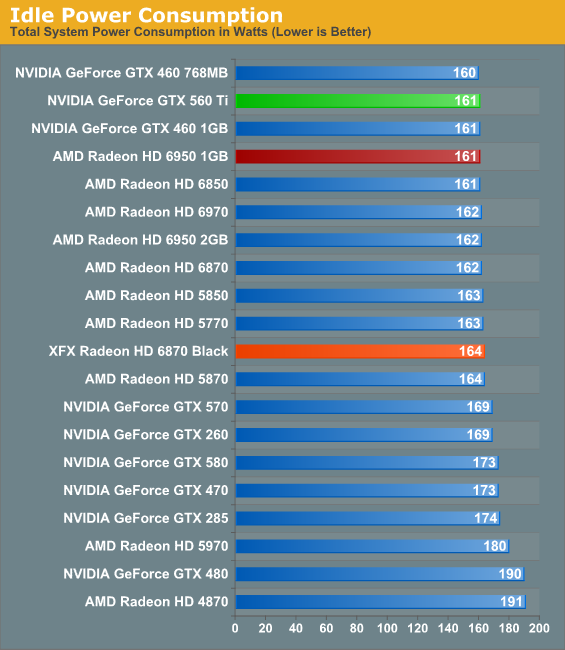

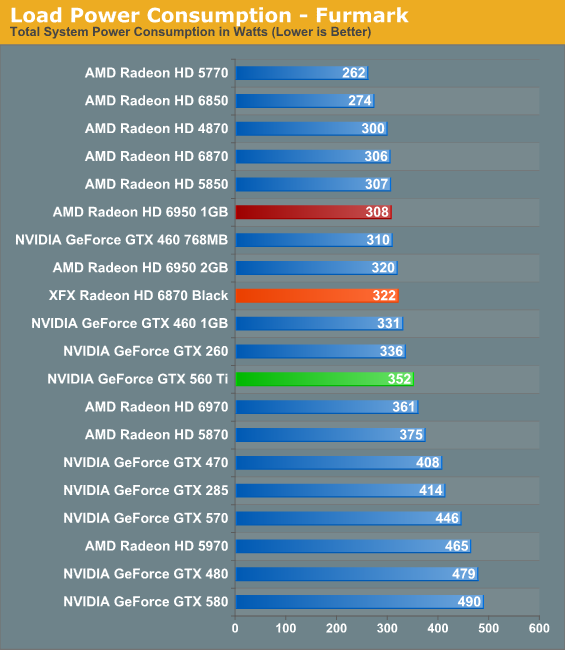
While the XFX 6870 has the same load voltage as the reference 6870, between the change in the cooler and the higher core and memory frequencies power usage still goes up. Under Crysis this is 11W, and under FurMark this expands to 16W. Unfortunately this factory overclock has wiped out much of the 6870’s low power edge versus the 6950, and as a result the two end up being very close. In practice power consumption under load is nearly identical to the GTX 460 1GB, albeit with much better gaming performance.
Meanwhile this is one of the few times we’ll see a difference between the 1GB and 2GB 6950. At idle and under Crysis the two are nearly identical, but under FurMark the 1GB reduces power consumption by some 12W even with PowerTune in effect. We believe that this is due to the higher operating voltage of the 2Gb GDDR5 modules AMD is using on the 2GB card.
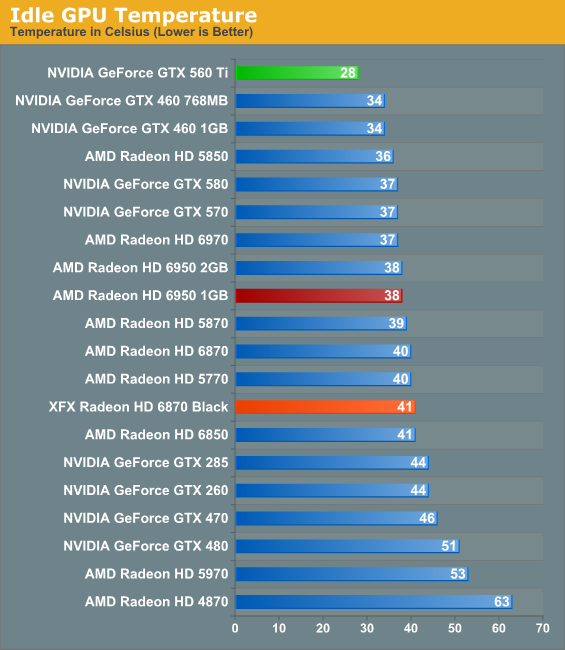


As far as temperatures go both cards are in the middle of the pack. The vapor chamber cooler on the 6900 series already gives it a notable leg up over most cards, including the XFX 6870. At 41C the XFX card is a bit warm at idle, meanwhile 78C under load is normal for most cards of this class. Meanwhile the 6950 1GB and 2GB both perform identically, even with the power consumption difference between the two.
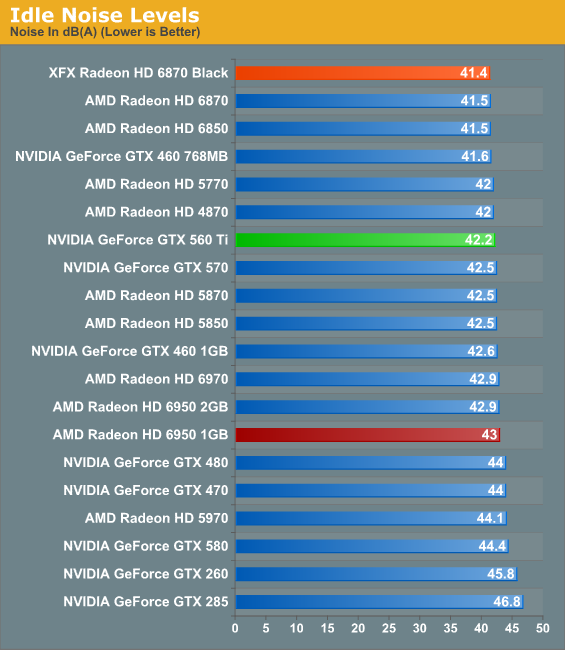
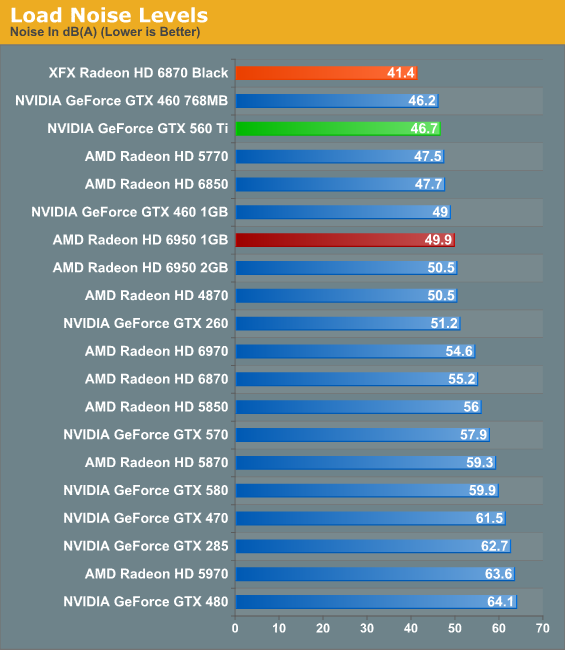
Last but certainly not least we have our noise testing, and this is the point where the XFX 6870 caught our eye. The reference 6870 was an unremarkable card when it came to noise – it didn’t use a particularly advanced cooling design, and coupled with the use of a blower it ended up being louder than a number of cards, including the vapor chamber equipped Radeon HD 6970. The XFX 6870 reverses this fortune and then some due to XFX’s well-designed open-air cooler. At idle it edges out our other cards by a mere 0.1dB, but the real story is at load. And no, that’s not a typo in the load noise chart, the XFX Radeon HD 6870 Black Edition really is that quiet.
In fact at 41.4dB under load, the XFX 6870 is for all intents and purposes a silent card in our GPU testbed. Under load the fans do rev up, but even when doing so the card stays below the noise floor of our testbed. Compared to the reference 6870 we’re looking at just shy of a 14dB difference between said reference card and the XFX 6870, a feat that is beyond remarkable. With the same warning as we attach to the GTX 460 and GTX 560 – you need adequate case cooling to make an open-air card work – the XFX Radeon HD 6870 Black Edition may very well be the fastest actively cooled quiet card on the market.
Meanwhile for the Radeon HD 6950 1GB and 2GB, we’re once again left with results that are nearly indistinguishable. Under load our 1GB card ended up being .6dB quieter, an imperceptible difference.










111 Comments
View All Comments
GeorgeH - Tuesday, January 25, 2011 - link
There is no bias at Anandtech, only well documented arguments and conclusions that you're free to disagree with. If you want to abandon one of the best tech review sites on the planet in favor of one that panders to your personal delusions about the fuzziness of a multinational corporation, knock yourself out.prdola0 - Tuesday, January 25, 2011 - link
I do not want to invalidate the arguments and facts in the article. No problem there. Just that they didn't include the OCed GTX560, which is going to be a major player.sinPiEqualsZero - Tuesday, January 25, 2011 - link
Find me a factory-overclocked GTX 560 that is currently available in the market. Then we can have that discussion. Anandtech is testing what is currently available - something I'm not sure you understand. All of these reviews are snapshots of a moment in time.My searching shows one as "OC" on newegg, but no details about the core clock. That isn't a sign that the site is biased, it's called reality.
prdola0 - Tuesday, January 25, 2011 - link
There are two already available (in Europe anyway): one from Asus and one from Gigabyte.omelet - Wednesday, January 26, 2011 - link
They're working on a review for the overclocked card. I don't think they've ever released benchmarks for factory overclocks the same day that the card comes out, at least not in recent history, so it's not unexpected for them not to have included overclocked GTX 560 data yet. Wait for the 560 overclocked article in a few days.Melted Rabbit - Tuesday, January 25, 2011 - link
The 850MHz GTX460 rarely ever in stock at online retailers during its lifespan, at times, the 810MHz GTX460 was even hard to find. The overclocked GTX460s that had even lower clocks were generally available. With these previous supply constraints in mind, why should any review site review another highly overclocked card like the 900MHz GTX560 Ti, when its predecessor was a low volume card created specifically to deceptively improve the perceived benchmarks and perceived value of the rest of the cards in its series?I have no issue with anandtech or other websites reviewing or including in reviews a 900MHz GTX560 if the variant is still readily available in four to six weeks. It would mean the card existed in reasonable quantities and was not just another Geforce 8800 Ultra card that showed up for the reviews and then was never actually in retail.
On the other hand, the 6870 Black is a modest overclock of the 6870 from AMD, who has not had and has no supply problems with the 6870 cards.
GeorgeH - Tuesday, January 25, 2011 - link
My personal experience is that EVGA's ~850MHz 460s have never impossible to find, although it has occasionally been difficult to find ones that weren't the less desirable external exhaust model. I've never had any difficulty finding ~810MHz cards.I didn't do much shopping around Christmas/New Years, though, so my experiences might not be representative of the average.
GeorgeH - Tuesday, January 25, 2011 - link
GTX 560 cards are going to be a major player? Really? You know this how? Because your talking points memo from Nvidia marketing told you so?If you honestly care about 560 OC results, here's what you can say - "Hey Ryan, will you be getting a chance to test any overclocked 560's soon? How do you think they will perform?"
Instead, here's what you went with - "OMG!! They didn't include every freaking card on the planet! BIAS! Sweet baby Jesus, I weep for the Anandtech that was!"
The only thing really missing from this article was the inclusion of an overclocked 460, which from previous benchmarks should be very competitive for $50 less. Unfortunately the ridiculous shitstorm from the last time it was included means we can't have nice things anymore.
prdola0 - Tuesday, January 25, 2011 - link
The Gigabyte and Asus OCed cards were available even before stock clocked cards. How is that in any way "temporary" or "uninterresting"? You are trying to downplay it really hard, but for apples-to-apples comparison, there should be the overclocked competition as well.GeorgeH - Tuesday, January 25, 2011 - link
Quotation marks - they do not mean what you think they mean. Nowhere on this page has anyone used either the words "temporary" or "uninteresting", nor any synonyms that I can see.No one is downplaying anything other than your ridiculous claim that AT and Ryan are biased because in two weeks they didn't manage to benchmark and write up every single card in the universe that might be relevant to your interests.